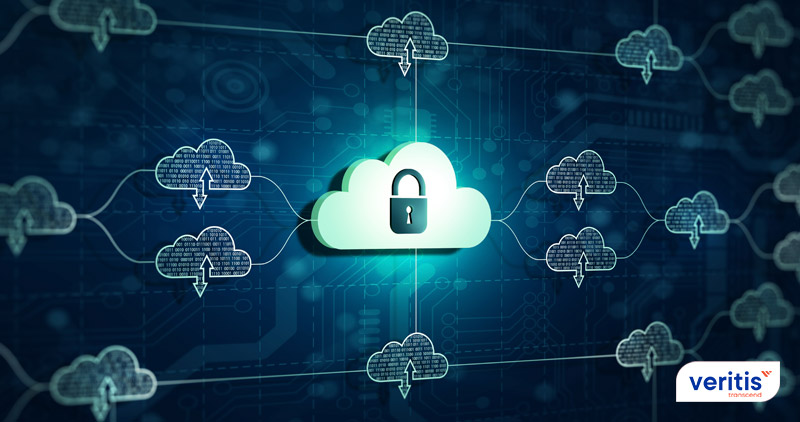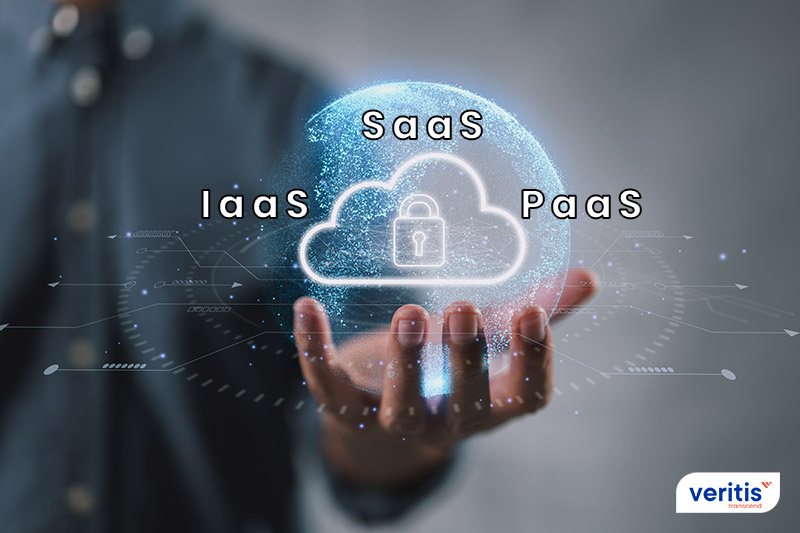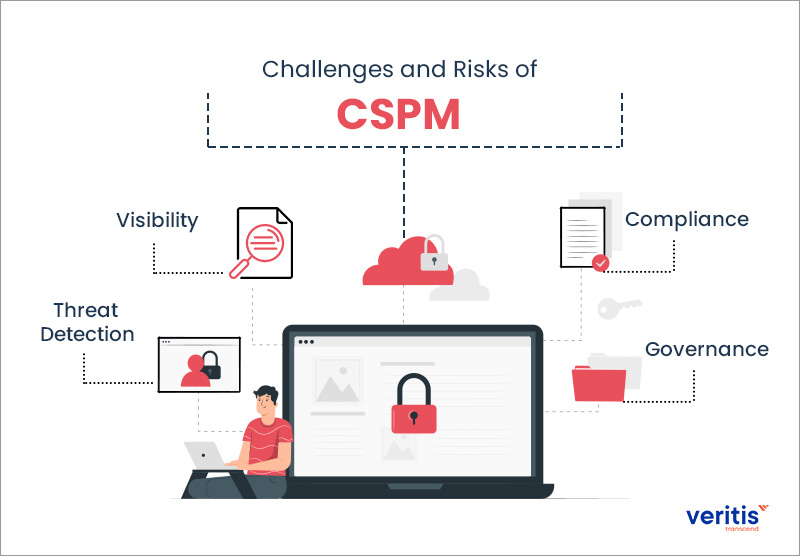
Table of contents
What is Cloud Security Posture Management (CSPM)?
Cloud Security Posture Management (CSPM) is a current market niche for IT security tools created to find cloud misconfiguration problems and compliance risks. Continuously checking the cloud infrastructure for inconsistencies in application of security policies is a key goal of Cloud Security Posture Management programming.
To extend security best practices to hybrid cloud and multi-cloud settings, enterprises that have embraced a cloud-first strategy frequently employ CSPM. CSPM is frequently linked to cloud services that provide Infrastructure as a Service (IaaS). The technology can also be utilized in cloud systems that leverage Software as a Service (SaaS) and Platform as a Service (PaaS) to decrease configuration errors and lower compliance concerns.
Companies embrace cloud computing data security and storage to reduce costs and improve agility. As more applications and data are moved to the cloud, the chance of compromised systems or data rises. Furthermore, it becomes more difficult to maintain security and compliance across environments when organizations roll out services in various public clouds.
Different Types of CSPM Infrastructures

CSPM is an automated software application used to find security threats in cloud infrastructure. Imagine CSPM as a building inspector who recognizes potential safety risks, except CSPM examines cloud-hosted software rather than actual buildings.
SaaS, PaaS, IaaS, containers, and serverless code may all be elements of the cloud infrastructure that CSPM examines. CSPM runs automatically. Rather than forcing security teams to verify their clouds for security issues manually. It runs in the background, assessing compliance risks and configuration exposures in the cloud.
Most Cloud security posture management tools can scan multiple cloud settings and deliver a consolidated view of security state across all cloud services. This skill is essential since many companies employ many cloud services, which can raise the possibility of misconfiguration and can be more challenging to manage manually.
The Cloud Security Posture Management (CSPM) tool automates cloud security management for the various infrastructures listed below:
1) Infrastructure as a Service (IaaS)
Provisioned and maintained immediately available computing infrastructure through the internet.
2) Software as a Service (SaaS)
A system that allows users to access and use cloud-based applications online.
Platform as a Service (PaaS)
Development and deployment on the cloud, with resources that let you build anything from straightforward cloud-based apps to experience-enabled business applications.
Today’s security experts’ stakes have increased due to cloud computing’s rapid growth and rising complexity. As a result, an organization’s most sensitive data may be exposed by a single, simple setup error, with disastrous financial and reputational repercussions.
However, it’s not as easy as working hard to avoid misconfigurations. The cloud’s characteristics make misconfiguration risks more likely. The cloud is programmable, expanding and changing with new resources and services, and it includes a cutting-edge tool that might be outside the scope of an internal IT team’s expertise. Enterprise cloud environments are also becoming big and complicated, so IT staff frequently find it challenging to manage these systems effectively. Making a permit mistake or misplacing important assets is far too common.
Companies today need cloud security solutions that compare compliance and security best practices with the real condition of the present cloud infrastructures to assess the risk posture associated with the cloud security strategy. This is performed through a process known as cloud security posture management.
Useful link: 10 Awesome Business Benefits of Cloud Computing Services
Why is CSPM So Important?
CSPM tools are key to securing a multi cloud environment by lowering the risk of data breaches. For instance, a cloud may connect to and disconnect from hundreds or thousands of other networks throughout the day. Cloud security posture management tools are strong because of their dynamic nature but are also challenging to protect.
The challenge of protecting cloud systems worsens when a “cloud-first” philosophy becomes the norm. AWS cloud security posture management vendors play a vital role in empowering the security of your cloud-based apps. The main uses of Cloud Access Security Brokers (CASB) are protection against threats and secure data.
Companies and employees have benefited from cloud service providers and cloud-based applications. It has led to unprecedented levels of productivity and flexibility. However, these tools can expose enterprise cloud security to a higher risk of cybersecurity attacks. It also includes data breaches, as they are easily accessible over the internet and can use by anyone. Sensitive data is at risk because security problems and exposures continue despite training and everyone’s best efforts.
How Does CSPM Work?

Tools for cloud security posture management (CSPM) are made to find and fix problems caused by incorrect cloud configurations. CSPM provides unique features such as continuous threat detection, misconfiguration management and remediation, and DevSecOps integration.
Continuous Threat Detection
Cloud security posture management detects risks throughout the application development lifecycle by sifting through the noise of multi cloud security warnings through a targeted approach to threat identification and management.
The CSPM prioritizes exposures depending on the conditions, focuses on the places opponents are most likely to use, and prevents powerless code from entering production. As a result, the number of alerts is decreased. In addition, the CSPM will also continuously monitor the environment for malicious activity, unauthorized activity, and unauthorized access to cloud services.
Misconfiguration Management and Remediation
By comparing cloud application configurations to industry and organizational benchmarks, CSPM reduces security risks and speeds up the delivery process so that violations may be found and fixed in real-time.
Guardrails are offered to help developers avoid errors. For instance, misconfigurations, open IP ports, illegal alterations, and other problems that expose cloud resources can be rectified with guided remediation. In addition, storage monitoring ensures that the correct permissions are always in place and that no data is ever unintentionally made publicly available.
DevSecOps Integration
CSPM lowers administrative costs by removing friction and complexity across several cloud providers and accounts. With cloud-native agentless posture management, all cloud resources are centrally visible and under your control. Security teams can control compromised assets from moving through the application lifecycle with a single source of truth for security operations and DevOps teams.
To improve visibility and gather information regarding incorrect setups and policy violations, the CSPM and SIEM should connect.
Additionally, the CSPM should be integrated with existing DevOps tool sets to enable quicker remediation and reaction inside the DevOps tool set. Teams from security operations, DevOps, and infrastructure may communicate more effectively thanks to reporting and dashboards.
Useful link: Security Integration – A Secret of Successful ‘Secure DevOps
Challenges and Risks of CSPM

Although public clouds provide numerous benefits, their success has exposed businesses to security threats. Because of the quick adoption of cloud services, dynamic and distributed settings have exploded. It is a problem for security teams to keep up with the size, rate of change, and “sprawl” across numerous public clouds. As a result, cloud-related skills are also in high demand.
“According to the Gartner survey, in 2021, 50% of enterprises will unintentionally have Infrastructure as a Service (IaaS) storage services, network segments, apps, or APIs directly exposed to the public internet, and nearly all these instances would be the consequence of configuration errors.”
These challenges and risks are motivating firms to implement a CSPM strategy. So look closely at some of the features cloud security posture management tools offer.
1) Threat Detection
Cloud data security threats can originate from different internal and external sources. However, we have covered the threat posed by misconfigurations. Companies must look for vicious insider threats and fair users abusing cloud data protection. Using stolen credentials by malicious actors, crypto mining, ransomware, and other malware and hacking tools are examples of external risks.
Insider threats or threats originating from compromised credentials are not identified until after a breach. To identify the attacker at that moment, SOC teams must manually filter through logs. Setting up a baseline of analytics on user behavior, followed by ongoing behavior monitoring, can help spot any anomalies and notify SOC teams before any potential harm is done.
2) Visibility
Gaining insight into all resources, applications, and data across cloud environments is challenging, as they include their existing security and compliance state, in contrast to data centers. CSPM security products allow consolidated, real-time visibility across cloud posture management environments by analyzing and normalizing various data sources and creating a thorough asset inventory.
Cloud security poster management vendors monitor existing resources and evaluate and display security posture in a single location, using graphics and tables that facilitate comprehension. Since security team members have experience in more than one public cloud condition, providing insight into several clouds in a single location is not only practical but also incredibly important.
3) Compliance
The privacy, security, and integrity rules that apply to data in the data center apply to cloud workload protection. However, proving compliance is far more challenging. Many firms cannot demonstrate compliance or pass a cloud environment audit without investing time and manual processes, such as creating and assembling various reports.
4) Governance
Data security rules are highly transparent within companies. However, it might be challenging for them to adopt and regularly enforce their policies in cloud workload protection because development teams frequently lack security knowledge.
Security operations center (SOC) teams frequently receive hundreds or thousands of security alerts daily from various tools across several clouds without the context to guide them in fixing problems. CSPM tools help the company’s cloud security strategy develop a strong security posture throughout the development lifecycle.
Why Veritis is Best for Cloud Security
Cloud Security Posture Management Advantages
There are multiple benefits of CSPM, and some of them are:
- HIPAA, SOC2, and PIC compliance are common standards for best practices.
- Finding incorrect network connectivity.
- There is potential to fix the misconfigurations in specific situations.
- Identifying lax account permissions and evaluating data risk.
- Monitoring the cloud environment continuously to identify any potential policy violations.
- Exposures in the cloud based apps and data detection.
- Analyzing the risk exposure of a company’s specific data configuration compared to compliance standards.
- Creating a baseline for a complete security configuration
Cloud Security Posture Management Disadvantages
Despite its many advantages, the CSPM security approach has certain drawbacks. Before using this strategy, for instance, firms must validate their business rules.
- It does not support environments with multiple tenants
- Requires carrying out certain activities that might not be consistent with current security procedures or cultural norms
- Requires additional operational work to track changes and manage various cloud vendors
- Depending on their operations, some businesses may need too much time and money to execute.
- For large businesses that require insight into all their actions across different clouds, it is not scalable enough
Conclusion
Protecting assets in the cloud has never been more difficult for IT pros. Nowadays, company environments are vast, intricate, and challenging to manage. Likewise, managing risk has never been challenging with the frequent integration of new cloud resources and applications. Furthermore, the IT staff often lacks the required skills to meet the expanding cloud security management needs.
Companies can use CSPM tools to help detect errors that might have gone undetected and address these cloud security challenges. In addition, companies may significantly decrease the risk of misconfigurations and other problems. However, that puts their most important assets at risk by automatically comparing cloud settings against best practices.
Veritis, the Stevie Award Winner, offers various technology services, including cloud containerization with cost-effective solutions. Our expertise provides solutions for challenging IT implementation projects and cutting-edge technologies in a changing environment.
Talk to Our Cloud Computing Expert
Additional Resources:
- Zero Trust Strategy, the Modern Security Solution for Cloud
- Security Breaches Rising Exponentially; Weak Authentications Exploited
- Cloud Security Automation: Best Practices, Strategy, and Benefits
- 9 Keys to Selecting a Right Cloud Managed Services Provider (MSP)
- Cloud Infrastructure Automation: The Imperative for Cloud Success!
- Hybrid Cloud Vs Multi Cloud: What’s the Difference!